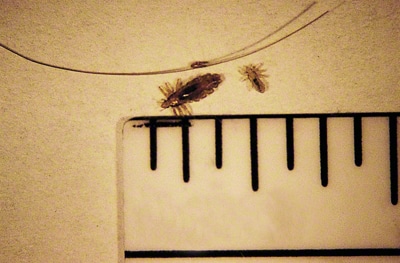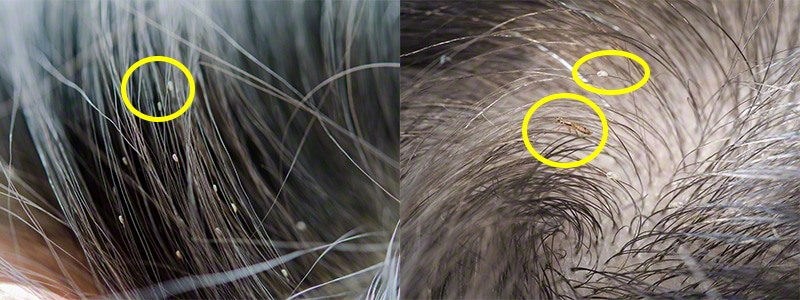These pictures of head lice show what they can look like at multiple stages of their life cycle.
Head lice look like small, wingless bugs equipped with 3 pairs of legs. Designed to crawl from hair strand to hair strand, lice do not jump or fly, but move quickly from one head to another. Head lice are small, approximately the size of a sesame seed. They can vary in color from clear to reddish-brown depending on when they last fed.


Head lice eggs, or nits, look like oval-shaped, white-ish brown specs. Smaller than lice, they are approximately the size of a poppy seed. To check if a white spec in the hair is a head lice egg or dandruff, blow on the spec. If it is easily dislodged it is dandruff. Head lice eggs are firmly attached to the hair shaft with a glue-like substance, making them incredibly difficult to remove.

Lice shown next to a ruler to reference size

As mentioned above, head lice look like tiny sesame seeds with legs and live on the scalp within the first ¼ inch of hair. Nits, or head lice eggs, will be firmly attached to the hair shaft close to the scalp. If a nit appears to be further than ¼ inch from the scalp, it is likely that it has hatched and only the shell remains.

Knowing what head lice and eggs (nits) look like will help when performing head lice checks. If you have children in daycare or preschool, it is important to check for head lice on a regular basis. If an outbreak occurs at your child’s school or daycare, perform head checks every couple of days. Once an outbreak has been contained, checking every two weeks will suffice. Or, if you or your children have had head lice, check daily after using a head lice treatment for 7 to 10 days after.
To begin, seat the child (or, adult!) under a lamp or near a window to make spotting head lice and lice eggs easier; a magnifying glass can also be used. Head lice prefer the nape of the neck and behind the ears, as these areas are warm and a great place to lay eggs (nits)! For long hair, comb into 2 inch sections and search thoroughly. Be sure to wash any combs or clips to avoid spreading head lice from one person to another.
Head Lice Lifecycle Facts: